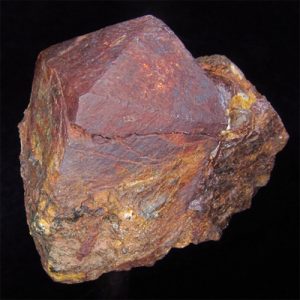Thorite
Thorite is an extremely rare gem and is highly radioactive. It is a member of the Zircon Group of minerals that includesCoffinite, Thorite and Zircon among others. Thorite is rarely found as crystals but normally found in massive form. Although Thorite contains about 72% thorium and is the most common thorium mineral, it is not the primary ore of thorium. The phosphate mineral Monazite only contains about 6% thorium but is mined in sufficient quantities to supply most of the current thorium demand. Thorite is an important ore of uranium. Because Thorite is highly radioacitve, it is often metamict. Metamict is the process in radioactive minerals of the destruction of the mineral’s internal crystal lattice by its own radioactivity. This process can completely destroy the crystal lattice while leaving the outward appearance unchanged.
Thorite is mainly for collectors of rare and unusual gems, black gems or radioactive gems. Thorite is a highly radioactive mineral and should be stored away from other minerals and gems that might be damaged by radioactivity. Human contact and exposure to Thorite mineral specimens or gems should be limited!
Distribution: In Norway, from Lomo, Brevik, and around the Langesundsfjord; at Ødegården, Bamble; also Arendal, Tvedestrand, Kragerö, and elsewhere. From Mendig, Eifel district, Germany. In Madagascar, at Ambatofotsy, Androtsabo, Befaritra, and elsewhere. In the USA, from the Baringer Hill pegmatite, 26 km west of Burnet, Llano County, Texas; at St. Peters Dome, near Pikes Peak, El Paso County, and the Powderhorn district, Gunnison County, Colorado; from the Wet Mountains, Custer County, Colorado. In Canada, as large but crude crystals from the McDonald mine, Hybla, and at Wilberforce, Ontario. Additional minor localities are known.
| Category: | Zircon |
| Chemical Formula: | (Th,U)SiO4 |
| Thorium Uranium Silicate | |
| Molecular Weight: | 324.12 gm |
| Composition: | Thorium | 71.59 % | Th | 81.46 % | ThO2 |
| Silicon | 8.67 % | Si | 18.54 % | SiO2 | |
| Oxygen | 19.74 % | O | |||
| 100.00 % | 100.00 % | = TOTAL OXIDE |
| Crystallography: | Tetragonal – Ditetragonal Dipyramidal |
| Crystal Habit: | Crystals typically square prisms, terminated by {111}, or pseudo-octahedral crystals, to 8 cm; also massive and compact |
| Twinning: | None |
| Cleavage: | Distinct on {110} |
| Fracture: | Conchoidal |
| Tenacity: | Brittle |
| Moh’s Hardness: | 4.5 – 5.0 |
| Density: | 4.00 – 6.70 (g/cm3) |
| Luminescence: | None |
| Radioactivity: | Very Strong; GRapi = 1,281,657.29 (Gamma Ray American Petroleum Institute Units) |
| Health Warning: | Contains thorium and uranium – always wash hands after handling. Avoid inhaling dust when handling or breaking. Never lick or ingest. Avoid prolonged exposure in proximity of the body. Store away from inhabited areas. |
| Color: | Orange, Yellow-Orange, Brownish Yellow, Brownish Black, Black |
| Transparency: | Opaque to Subtranslucent; transparent in thin fragments |
| Luster: | Resinous, Greasy, Dull |
| Refractive Index: | 1.78 – 1.84 Uniaxial ( + ) (metamict) |
| Birefringence: | 0.010 – 0.020 |
| Dispersion: | n/a |
| Pleochroism: | None |


